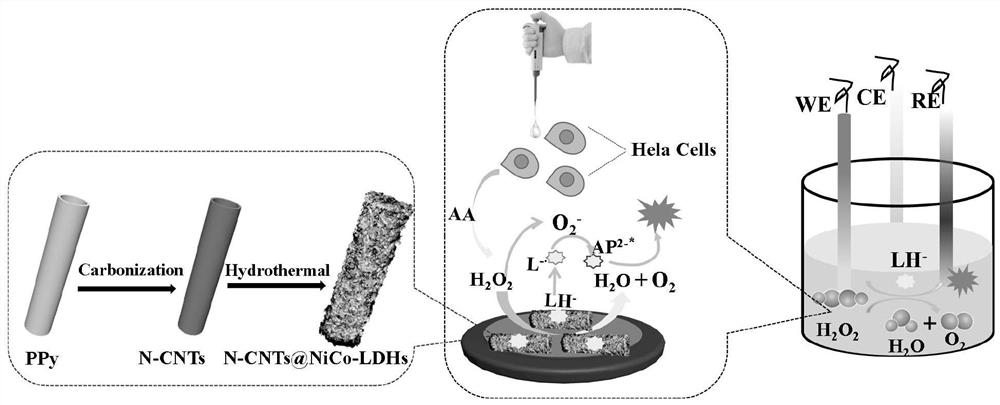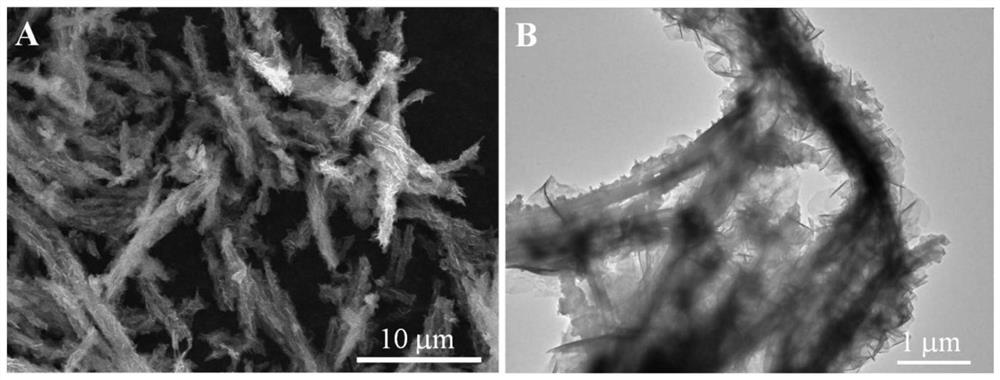N-CNTs@NiCo-LDHs dendritic nanoflower material and preparation method and photoelectrochemical application thereof
A nano-flower and tree-like technology, applied in the field of biosensing, can solve the problems of easy inactivation of enzymes, low cost and high cost, and achieve the effects of stable nature, low price, and reduction of oxidative overpotential.
- Summary
- Abstract
- Description
- Claims
- Application Information
AI Technical Summary
Problems solved by technology
Method used
Image
Examples
Embodiment 1
[0038] Weigh 1.5710g of methyl orange and dissolve it in 100mL of water to form a transparent solution, quickly add 0.7780g of anhydrous FeCl 3 , keep at 1200r / min for 30min to form a uniform fibrous composite suspension, and use the fibrous composite as a self-degradation template.
[0039] Add 0.84mL of Py monomer dropwise to the above-mentioned fibrous composite suspension, and keep it under magnetic stirring at 1200r / min at a temperature of 25°C for 24h, so that Py is uniformly aggregated on the surface, and the Buchner funnel is used to reduce After pressure filtration, wash with secondary water and absolute ethanol several times until the filtrate becomes colorless to remove excess methyl orange, and then dry the filtered product in an oven at 60°C for 12 hours to obtain PPy. Finally the PPy solid in N 2 Under the atmosphere, the temperature was raised to 800°C at a rate of 5°C / min and kept for 2 hours to obtain black N-CNTs.
[0040] Weigh 40 mg of the above-synthesiz...
Embodiment 2
[0042] Weigh 1.5710g of methyl orange and dissolve it in 100mL of water to form a transparent solution, quickly add 0.7780g of anhydrous FeCl 3 , keep at 1200r / min for 30min to form a uniform fibrous composite suspension, and use the fibrous composite as a self-degradation template.
[0043] Add 0.84mL of Py monomer dropwise to the above-mentioned fibrous composite suspension, and keep it under magnetic stirring at 1200r / min at a temperature of 25°C for 24h, so that Py is uniformly aggregated on the surface, and the Buchner funnel is used to reduce After pressure filtration, wash with secondary water and absolute ethanol several times until the filtrate becomes colorless to remove excess methyl orange, and then dry the filtered product in an oven at 60°C for 12 hours to obtain PPy. Finally the PPy solid in N 2 Under the atmosphere, the temperature was raised to 800°C at a rate of 5°C / min and kept for 2 hours to obtain black N-CNTs.
[0044] Weigh 40 mg of the above-synthesiz...
Embodiment 3
[0046] Weigh 1.5710g of methyl orange and dissolve it in 100mL of water to form a transparent solution, quickly add 0.7780g of anhydrous FeCl 3 , keep at 1200r / min for 30min to form a uniform fibrous composite suspension, and use the fibrous composite as a self-degradation template.
[0047] Add 0.84mL of Py monomer dropwise to the above-mentioned fibrous composite suspension, and keep it under magnetic stirring at 1200r / min at a temperature of 25°C for 24h, so that Py is uniformly aggregated on the surface, and the Buchner funnel is used to reduce After pressure filtration, wash with secondary water and absolute ethanol several times until the filtrate becomes colorless to remove excess methyl orange, and then dry the filtered product in an oven at 60°C for 12 hours to obtain PPy. Finally the PPy solid in N 2 Under the atmosphere, the temperature was raised to 800°C at a rate of 5°C / min and kept for 2 hours to obtain black N-CNTs.
[0048] Weigh 40 mg of the above-synthesiz...
PUM
 Login to View More
Login to View More Abstract
Description
Claims
Application Information
 Login to View More
Login to View More - R&D
- Intellectual Property
- Life Sciences
- Materials
- Tech Scout
- Unparalleled Data Quality
- Higher Quality Content
- 60% Fewer Hallucinations
Browse by: Latest US Patents, China's latest patents, Technical Efficacy Thesaurus, Application Domain, Technology Topic, Popular Technical Reports.
© 2025 PatSnap. All rights reserved.Legal|Privacy policy|Modern Slavery Act Transparency Statement|Sitemap|About US| Contact US: help@patsnap.com



